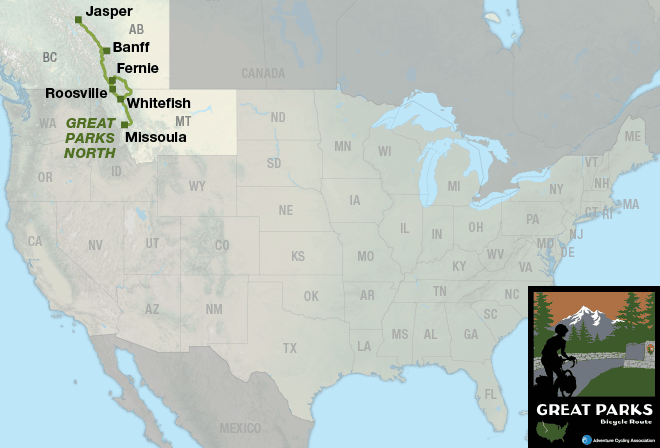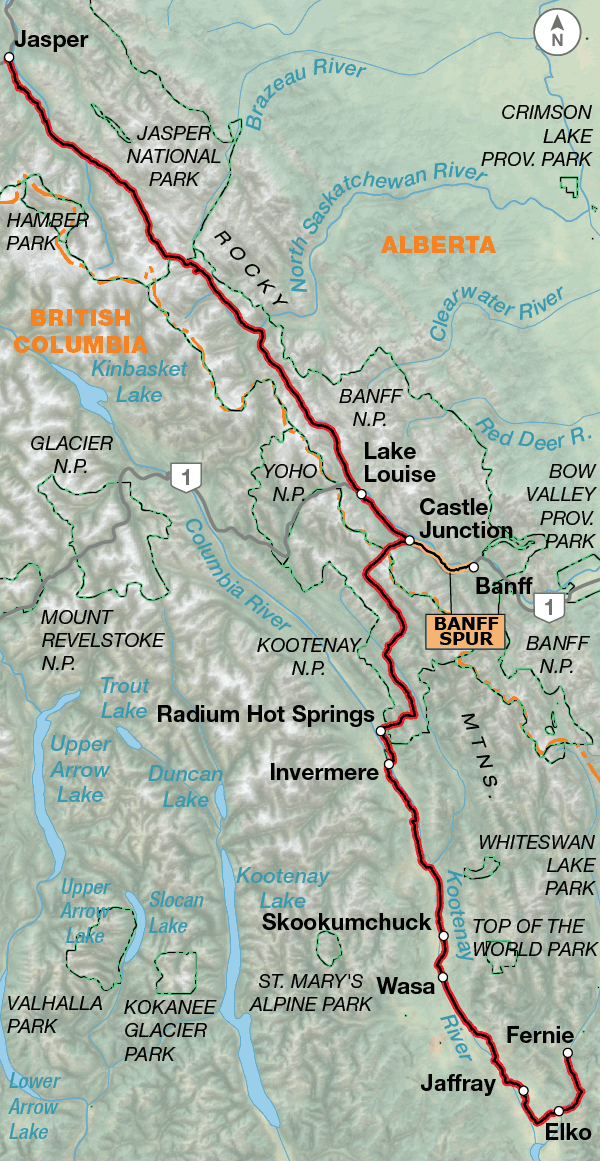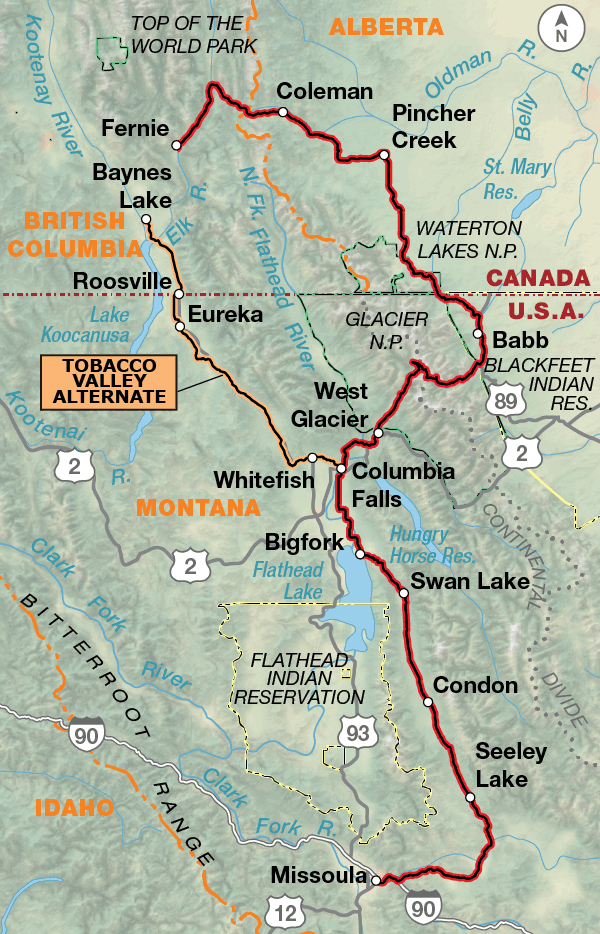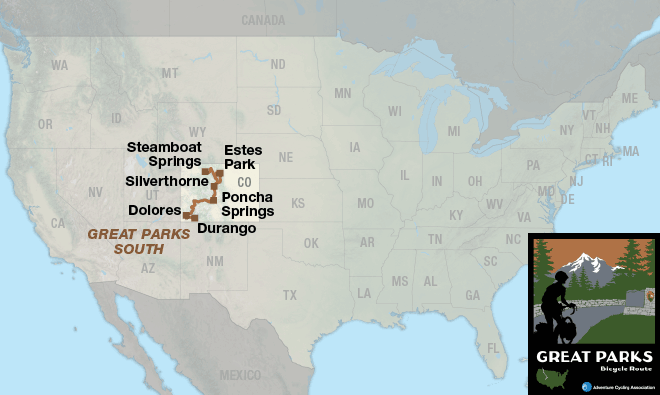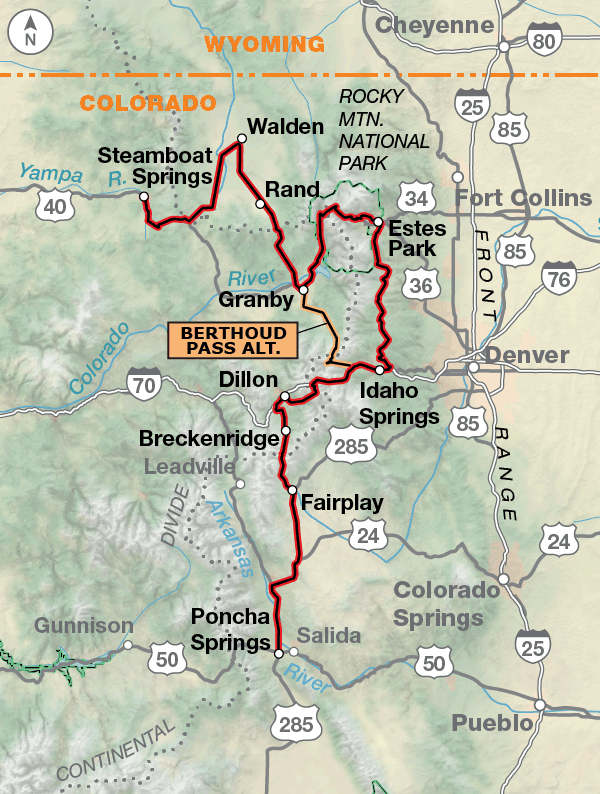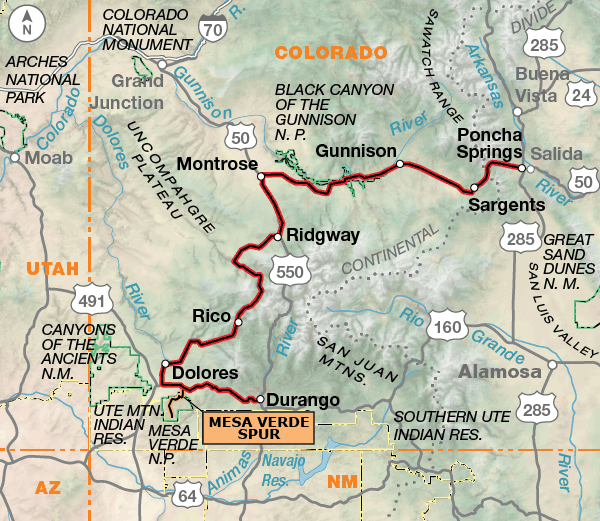Great Parks
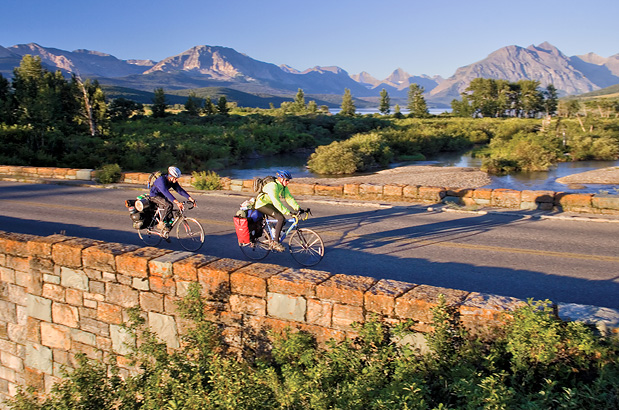
| Great Parks North Jasper, AB to Missoula, MT 2 Map Set | GPX Data | Overview | Buy | Mobile App |
|---|---|
| 1. Jasper, AB to Fernie, BC | Detail |
| 2. Fernie, BC to Missoula, MT | Detail |
| Great Parks South Steamboat Springs, CO to Durango, CO 2 Map Set | GPX Data | Overview | Buy | Mobile App |
|---|---|
| 1. Steamboat Springs, CO to Poncha Springs, CO | Detail |
| 2. Poncha Springs, CO to Durango, CO | Detail |
Due to limited resources, the paper map versions of the Great Parks South route have been discontinued and will no longer be available once sold out. Both sections of this route are still available digitally. The Great Parks North route is still available as paper and digital. More info here: Going Digital: App or GPX.
Experience spectacular parks in the United States and Canada.
These two separate routes traverse the Rocky Mountain national parks of Canada and the U.S. When combined with TransAmerica Trail sections 4, 5, and 6, it is a continuous route from Jasper, Alberta, to Durango, Colorado. Below, you’ll find details on both the North and South routes.
Great Parks North
Following the spine of the northern Rocky Mountains, this route ambles through some of the most sublime (and accessible) mountain scenery found in Canada and the contiguous United States.
Even in the height of summer, cyclists must be prepared for cold nights and occasional snow in the higher elevations. The Canadian parks, with their wide road shoulders, provide excellent cycling conditions, though motorized traffic during the tourist season is heavy. Towns outside the parks, such as Fernie, British Columbia, offer information and ample opportunities for the off-road cycling enthusiast. Fascinating side trips abound for natural and geological sightseeing, which include aerial trams, hiking onto glaciers, and whitewater rafting. So, allow extra time beyond bicycling for these activities.
The route begins in Jasper, Alberta, a busy tourist center in the heart of Jasper National Park, one of the five Canadian Parks the route traverses. You will be amazed by the scenery: glacial lakes, dramatic waterfalls, piercingly steep mountains covered with glaciers, and a tremendous variety of wildlife; you will stop frequent just to marvel at the beauty. Be sure to ride cautiously among the tourists in recreational vehicles. As you head south, over several passes through the parks, take the time to go to Lake Louise and Banff, which both offer a wide variety of tourist services and charm. After 230 miles of amazing vistas, you’ll leave Kootenay National Park and descend steeply into the town of Radium Hot Springs. Stop for an enjoyable soak in the soothing hot mineral pools. From Radium Hot Springs southward to Elko, the western side of the Rockies offers gentler cycling following the Columbia and Kootenay river systems. At Elko, the route turns east over the Continental Divide through a series of small mining communities. You’ll see the prairies begin on the eastern slope and traverse the foothills through Waterton Lakes National Park, another mountain jewel of the Canadian Parks. The border crossing into the United States at Chief Mountain is only open from mid-May through mid-September, and then you’re in Glacier National Park in Montana, crossing the Divide back to the western side on the spectacular Going-to-the-Sun Road. You’ll find no major climbs or descents after leaving the park, and the route mainly follows river valleys bracketed by mountain ranges all the way into Missoula.
Great Parks South
This route, entirely in the Colorado Rocky Mountains, offers challenging biking, including riding on Trail Ridge Road, the highest continuous paved road in the continental United States, located in Rocky Mountain National Park. Eleven miles of it are above treeline.
The cyclist is rewarded by a continuous setting of dramatic mountain scenery, national forests, parks, monuments, and many climbs and descents over passes. Off-road mountain-biking opportunities abound at the various ski hills along the route, which offer singletrack riding on quiet forest trails, serviced by bustling tourist villages.
The route begins in northern Colorado in the ski town of Steamboat Springs. After a gut-busting climb out of Steamboat Springs to Rabbit Ears Pass and Muddy Pass, you’ll find open grazing land and national forest lands heading to Granby, near the southern entrance to Rocky Mountain National Park. Traffic can be heavy approaching the park and throughout the park, and you’ll spend many hours climbing and descending Trail Ridge Road. From Estes Park to Georgetown, this area is the playground for Denver, the surrounding communities on the Front Range and also much of the nation. Communities from Keystone to Breckenridge have become major year-round tourist destinations, so be prepared for traffic and recreational vehicles. There is a very good paved trail system in Summit County. South of Fairplay, the route becomes rural and traverses the high, open land of South Park. After crossing Trout Creek Pass, the route drops into the Arkansas River Valley near Buena Vista. The western slope of the Colorado Rocky Mountains is old mining country, from Salida all the way into Durango. Around Dolores, the mountains give way to the dry, open Four Corners region, highlighted by Mesa Verde National Park. Durango is the southern terminus of the historic Durango and Silverton Narrow Gauge Railroad, the only remaining regularly scheduled narrow-gauge passenger train.
Photo by Chuck Haney
Great Parks North
The Great Parks North terrain is a series of climbs and descents over passes into various river valleys. In the southern part of the route, you’ll stay in the valleys and experience rolling terrain. The route crosses the Continental Divide three times.
Great Parks South
On Great Parks South, you will cross eleven mountain passes, and six of these will be over the Continental Divide. The highest point on the route is at 12,183 feet in Rocky Mountain National Park. The route follows a few river valleys, but for the most part you will be either climbing or descending.
| Great Parks North - Main Route | ||||
|---|---|---|---|---|
| Section | Distance | Elevation | Total Climb | Avg. Climb/mile |
| Total | 741.0 miles | Minimum: 2,470 ft.Maximum:6,825 ft. | 40,775 ft. south bound40,765 ft. north bound | 55 ft. per mi. south bound55 ft. per mi. north bound |
| 1 | 370.2 miles | Minimum: 2,470 ft.Maximum:6,825 ft. | 21,055 ft. south bound21,015 ft. north bound | 57 ft. per mi. south bound57 ft. per mi. north bound |
| 2 | 370.8 miles | Minimum: 2,895 ft.Maximum:6,650 ft. | 19,720 ft. south bound19,750 ft. north bound | 53 ft. per mi. south bound53 ft. per mi. north bound |
| Great Parks South | ||||
|---|---|---|---|---|
| Name | Section | Distance | Total Climb | Avg. Climb/mile |
| Total | 695.0 miles | Minimum: 5,805 ft.Maximum:12,175 ft. | 53,075 ft. south bound53,293 ft. north bound | 76 ft. per mi. south bound77 ft. per mi. north bound |
| 1 | 386.8 miles | Minimum: 6,700 ft.Maximum:12,175 ft. | 30,930 ft. south bound30,065 ft. north bound | 80 ft. per mi. south bound78 ft. per mi. north bound |
| 2 | 305.5 miles | Minimum: 5,805 ft.Maximum:11,320 ft. | 22,185 ft. south bound23,228 ft. north bound | 73 ft. per mi. south bound76 ft. per mi. north bound |
| Great Parks North Alternates | ||||
|---|---|---|---|---|
| Name | Section | Distance | Total Climb | Avg. Climb/mile |
| Banff Spur | 1 | 19.0 miles | 910 ft. south bound1,330 ft. north bound | 48 ft. per mi. south bound70 ft. per mi. north bound |
| Gravel Alternate | 1 | 20.9 miles | 1,425 ft. south bound1,310 ft. north bound | 68 ft. per mi. south bound63 ft. per mi. north bound |
| Tobacco Valley Alternate | 2 | 100.0 miles | 4,955 ft. south bound4,950 ft. north bound | 50 ft. per mi. south bound50 ft. per mi. north bound |
| Great Parks South Alternates | ||||
|---|---|---|---|---|
| Name | Section | Distance | Total Climb | Avg. Climb/mile |
| Berthoud Pass Alternate | 1 | 47.0 miles | 4,095 ft. south bound3,795 ft. north bound | 87 ft. per mi. south bound81 ft. per mi. north bound |
| Mesa Verde Spur | 2 | 52.3 miles | 5,890 ft. clockwise ft. clockwise | 113 ft. per mi. clockwise ft. per mi. clockwise |
Great Parks North
This route should be ridden from early summer to mid-fall (typically June to September). Going-to-the-Sun Road in Glacier National Park is usually closed until early to mid June and has limited hours for cyclists which is noted on the map. Snow can occur at any time during the summer in the Rocky Mountains so be prepared with cold weather gear. Due to changing local conditions, it is difficult to predict any major wind patterns.
Jasper can be reached by rail service from Edmonton, Alberta. Along the entire length of the route, small towns at regular intervals provide ample services, but plan ahead due to crowded tourist conditions, especially in the Canadian Park System and in Glacier National Park. Reservations at both hostels and campgrounds are recommended. For off-road bicycling and primitive camping, a water purifier is necessary.
Great Parks South
This route can be ridden from early summer to mid-fall (typically June to September). Trail Ridge Road is closed between October and June. Snow can occur at any time during the summer in the Rocky Mountains. Altitude sickness can slow you down, so preparation for the high altitude is important. Arriving a few days before your trip begins is a good way to acclimate.
In Colorado, high-altitude services from campground water to grocery stores can shut down early in the autumn depending on weather. A water purifier is recommended. Due to high levels of tourist activity in the summer, reservations for accommodations and campgrounds are recommended.
Great Parks North and South may be connected into one route by adding TransAmerica Trail Sections 4, 5, and 6.
Some campgrounds will charge a cyclist traveling alone less if they have hiker/biker sites, but often they will charge the price of a regular tent site, and that can easily be $10-$20/night. The maps list churches that have opened their doors to cyclists, but they aren’t all that closely spaced. If you’re friendly and ask around, you can often get yourself invited to camp in a yard. In the U.S. our routes go through national forests (moreso in the west) and you are allowed to camp anywhere on national forest land as long as you “pack it in, pack it out.” Many city parks are free to camp in.
You may also wish to sign up with Warmshowers, a reciprocal hospitality site for bicycle travelers, for other overnight options.
Route Highlights
Great Parks Highlights
- Jasper National Park, Great Parks North Section 1
- Banff National Park, Great Parks North Section 1
- Kootenay National Park, Great Parks North Section 1
- Waterton Lakes National Park, Great Parks North Section 2
- Going-to-the-Sun Rd., Great Parks North Section 2
- Glacier National Park, Great Parks North Section 2
- Rocky Mountain National Park, Great Parks South Section 1
- Black Canyon of the Gunnison National Park, Great Parks South Section 2
- Telluride, Colorado, Great Parks South Section 2
- Mesa Verde National Park, Mesa Verde Spur, Great Parks South Section 2
More Route Resources
- Great Parks North and South may be connected into one route by adding TransAmerica Trail Sections 4, 5, and 6.
- Sun Dog Tours Shuttle Service between Jasper and Banff
- U.S./Canada Visa Information
- U.S. Chief Mountain border crossing
- Canadian Chief Mountain border crossing
- Roosville Border Crossing
- Bicycling in Glacier National Park
- Going-to-the-Sun Road Information
- Rocky Mountain National Park
- Summit County, Colorado bicycling information
- Mesa Verde National Park bicycling restrictions
- Connect and share photos with other riders on Instagram: #acaGrParksN and #acaGrParksS
Updates to Recently Released Maps
If you are planning a bike tour, be sure to get the most recent map updates and corrections for your route by selecting the route, and the appropriate section(s), from the drop-down menu below.
Over time maps become less useful because things change. Every year Adventure Cycling’s Routes and Mapping Department create map updates and corrections for every map in the Adventure Cycling Route Network, which now totals 52,047 miles. With the help of touring cyclists like you, we receive updates on routing, services, camping, and contact information. Until we can reprint the map with the new information, we verify the suggested changes and publish corrections and updates here on our website.
PLEASE NOTE: Covid has been particularly hard on the small businesses along our routes. While we do our best to keep the maps and these online updates current, you may encounter more closed businesses and longer stretches with limited or no services.
Refer to these updates for the most current information we have and submit reports of changes to the Route Feedback Form for the cyclists coming after you.
NOTE: Map updates and corrections only pertain to long term changes and updates. For short term road closures, please see the Adventure Cycling’s Routes Temporary Road Closures discussion in our Forums.
